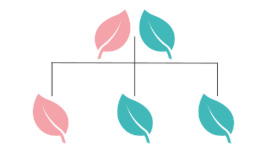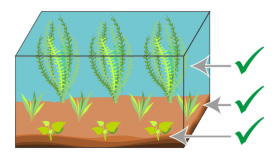

Alternative species (click on the thumbnail to see the card)
Names
Scientific name
Sagittaria subulata
Sagittaria natans
Alisma subulatum
Common name
Dwarf sagittaria
Awl-leaf arrowhead
Narrow-leaved arrowhead
Origin

Origin: Central America
Ideal fertilization

CO2: 10-40mg/l
Nitrates (NO3): 10-50mg/l
Phosphates (PO4): 0,1-3mg/l
Potassium (K): 5-30mg/l
Iron (Fe): 0,01-0,5mg/l
Group

Alismatacae
Kind

Rhizome
Parameters

T°: 18 to 28°C or 64 to 82°F
pH: 6 to 8
Hardness: 10 to 25°dGH
Difficulty

Easy
Lighting

Strong
Size

15 to 50cm (6 to 20")
Plantation

Everywhere (depending on variety)
Growth

Fast
Presentation
Who is the Dwarf sagittaria?
Presentation
Who is the Dwarf sagittaria?
In the wild, this plant is found in Central American rivers and streams. This pretty, unobtrusive plant will form a bushy bush.
More than its maintenance, it is also its variety that will determine the final size of this plant. Indeed, some will not exceed 15 cm or 6" (like the Sagittaria subulata var. Pusilla) while others will happily reach 50 cm or 20"! It is a polymorphic plant, which means that it can considerably change its appearance from one aquarium to another.
It is a plant of choice for aquariums such as Tanganyika or Malawi, because it resists quite well to herbivorous fish.
Very easy to install and maintain, this plant will delight all beginners with a suitable aquarium size.
Planting and maintenance
How to plant and maintain the Dwarf sagittaria?
Planting and maintenance
How to plant and maintain the Dwarf sagittaria?
Given its probable final size, it is best to install your Sagittarius feet on the bottom of the aquarium, or on the sides (except for the smaller varieties, which you will enjoy best at the front of your aquarium). If you like it, it will form a very aesthetic plant barrier.
To do this, plant your feet at a rate of 4 or 5 units every 15 cm or 6". Over time, the plant will eventually expand and fill in the gaps. However, to achieve such a result, it will need a lot of light, even if it can make do with less intense light conditions.
In terms of maintenance, it is not really demanding and will even be able to make do with tap water and simple Loire sand. Its only need is essentially correct lighting (from strong to intense), which is essential for its survival.
However, beware of iron deficiencies which cause its leaves to turn yellow.
The diffusion of CO2 would be a plus but it is not essential.
You can lighten your plant so that it does not grow too high. Of course, cut off the damaged leaves first.
Farming
How to farm the Dwarf sagittaria?
Farming
How to farm the Dwarf sagittaria?
Some axes will develop runners. Cut them out and replant them leaving 2-4 cm (0.8 to 1.6") of space between each foot. That's it!
Good To know
Find all additional information!
Good To know
Find all additional information!
It has no stem!
Under favourable conditions, its growth may be, even brutal! Move it and it will tend to diminish.
For the luckiest ones, the plant will offer a delicate flowering. The flower spike will then emerge and give small yellow and white flowers.
Yours photos!
Comments
Sort by:
Please login to post comments


